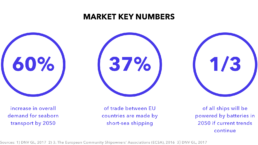International trade relies on shipping, and despite technological improvements, emissions continue to increase as trade increases. Decarbonising short-haul shipping is an expanding market opportunity driven by developments in battery technology and alternative fuels, with the potential to help the sector’s low-carbon transition.
Maritime transport is essential to the world’s economy, handling more than 90% of the world’s trade as the most costeffective and least carbon-intensive method of transporting goods. Increases in fuel consumption due to greater demand for shipping are outpacing recent efficiency improvements. In 2015, shipping was responsible for 2.6% of global carbon emissions. And although the IMO has already introduced measures which aim to improve shipping’s emissions, there still remain opportunities for the sector to improve its carbon footprint and overall environmental impact. Using current technologies more extensively throughout the maritime sector, could make a significant impact on shipping’s emissions. Through a combination of efficiency measures, speed reductions, changes in the fleet composition, logistical measures and use of alternative fuels, the global fleet could reduce its tonne mile consumption by 35-40% by 2050. To reach these emission reductions the world fleet will need a significant transformation with about 50% of the world’s fleet shifting towards alternative fuels such as liquified natural gas and biofuels.
Although short-range shipping accounts for just 15% of maritime emissions, decarbonising it offers a quick-win solution and can act as a stepping stone for tackling long-range shipping emissions by testing technologies in a living laboratory.

Products and Services
A plethora of new products will be needed to reduce emissions from the sector. As well as full electrification, installing hybrid power solutions incorporating hydrogen and renewables can achieve impressive cost and carbon savings. An example is the the Norsepower Rotor Sail Solution, which can reduce fuel consumption by up to 20% through harvesting the wind to generate electricity.
New products that optimise operations offer many benefits, from advanced paints that reduce drag to autonomous ships with more efficient routing. Such ships are in development, such as the YARA Birkeland – the world’s first zero-emission, autonomous container feeder, expected to be fully operational in 2020. However, a high penetration of autonomous ships will require significant changes in the regulatory framework. Building fast, easy, and safe connections to high-voltage electricity when in harbour is becoming increasingly important. Innovative new products and services in this space are emerging, such as wireless charging technologies, primarily for short-range ferries.

Market Size and Demand Drivers
Sustainability is a growing priority for the sector’s multinational clients, creating demand for more sustainable shipping alternatives. As progress towards an internationally agreed strategy to tackle climate change in shipping continues, low-carbon alternatives offer economic benefits resilient to a turbulent future.
Decarbonising the shipping industry will involve a range of different approaches, including soft measures, such as speed, capacity, and route optimisation. While a zero-carbon shipping sector is not yet within reach, the new technologies coming to market are a step in the right direction, and by rapidly implementing them in short-haul scenarios, this transition will accelerate.
This market featured in the 2018 Global Opportunity Report.

